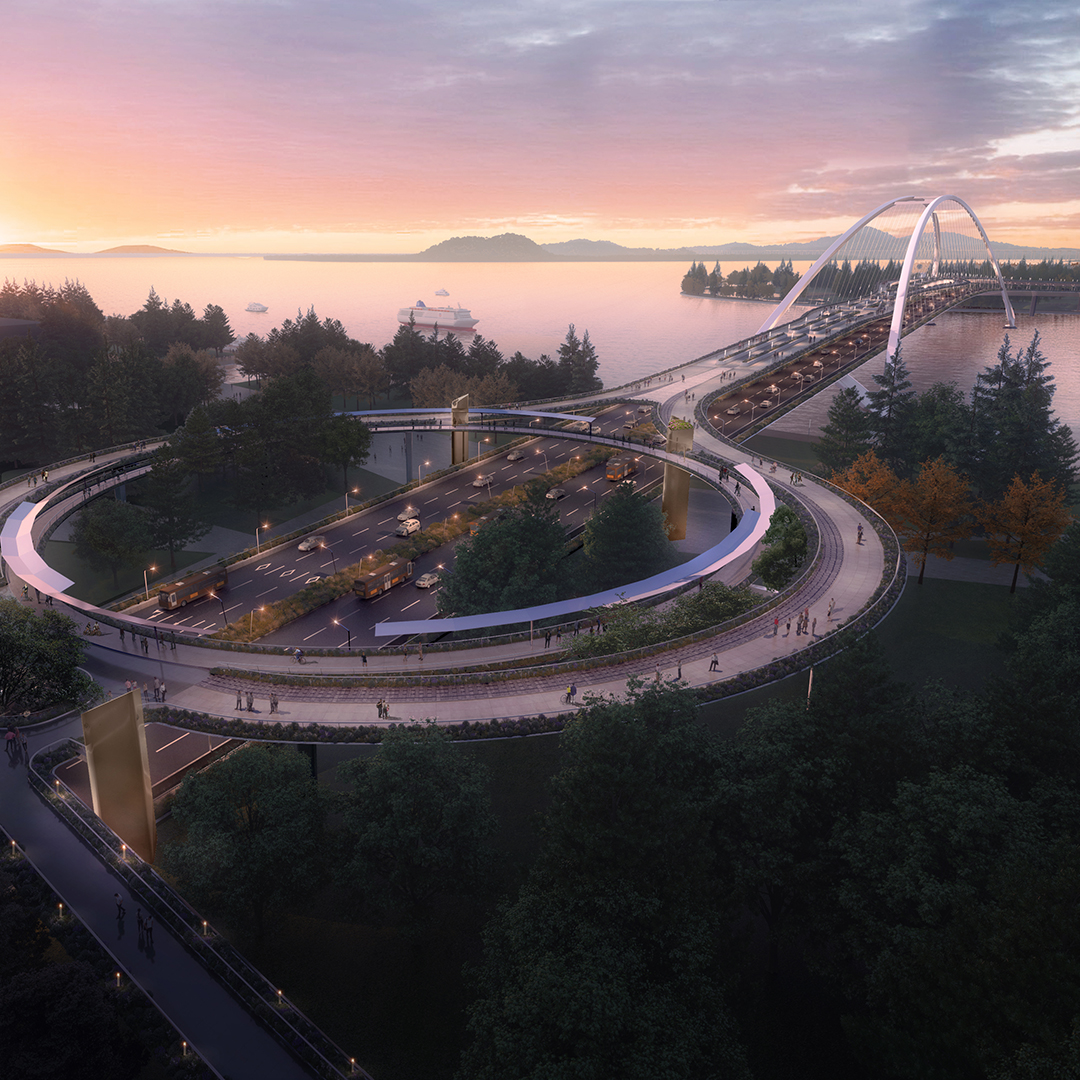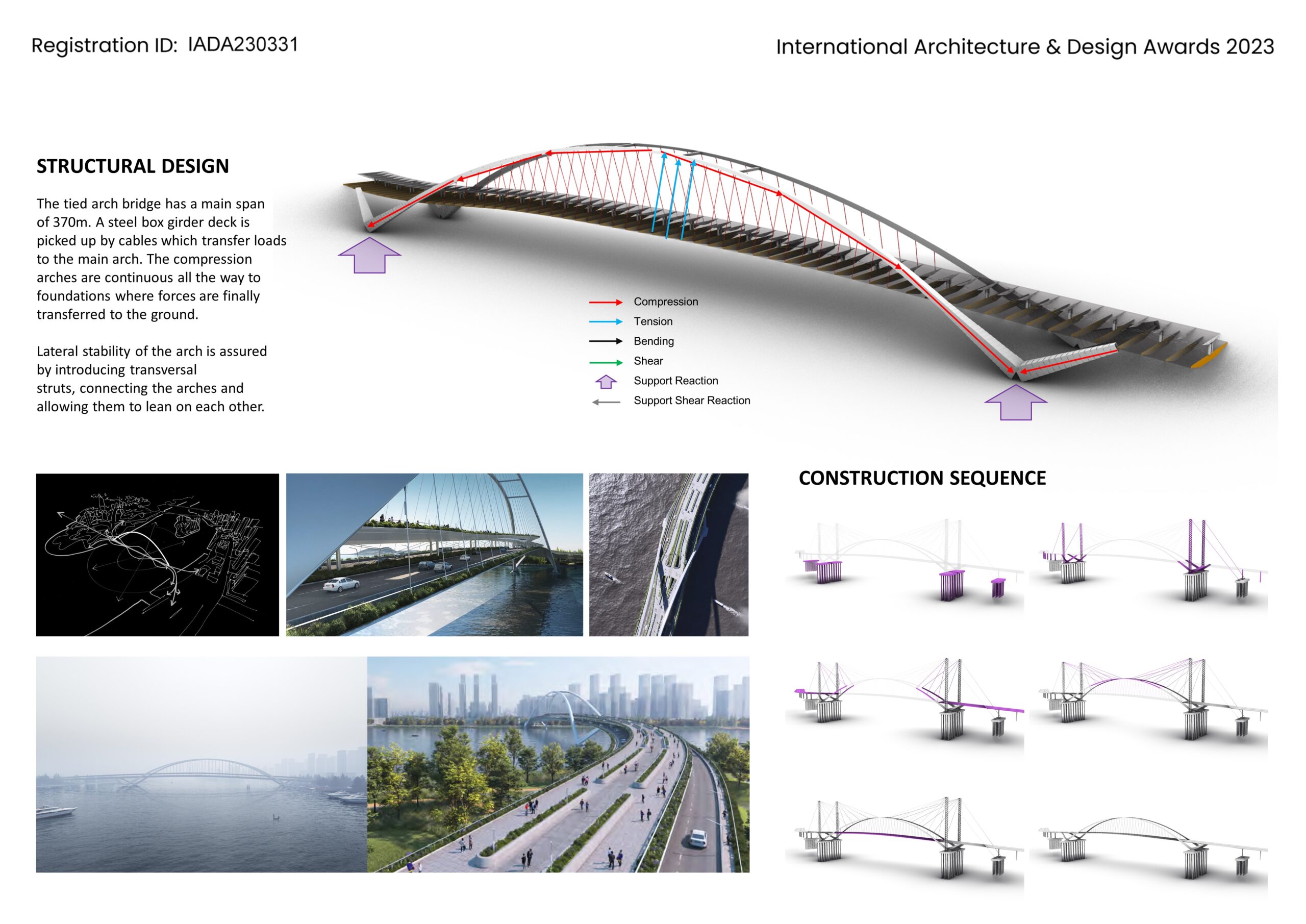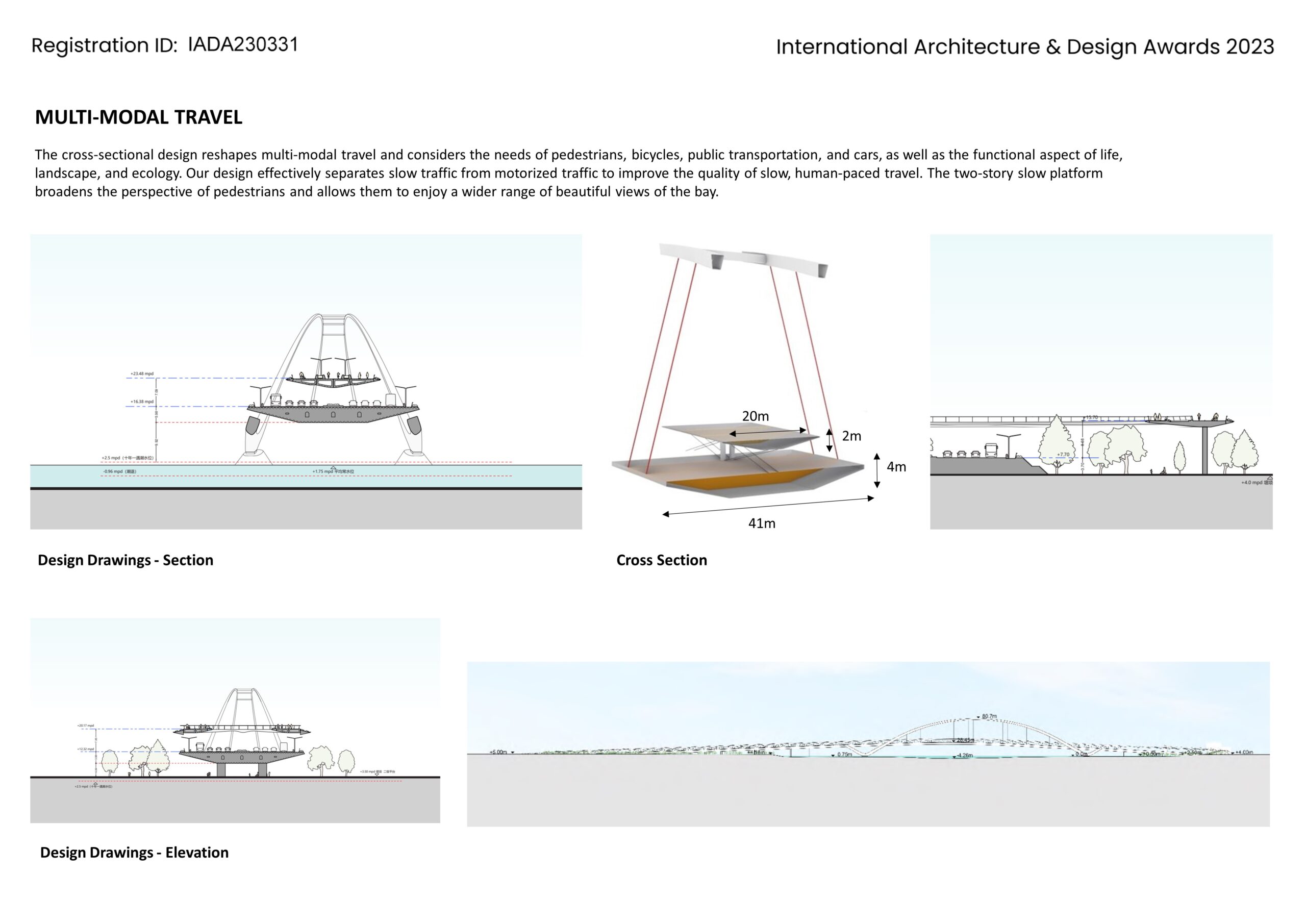Gold Winner of the International Architecture & Design Awards 2023
Architect / Designer:
WilkinsonEyre & MLA+
Studio:
Cundall
Design Team:
Engineers:
Cundall: Dong Chen, Nan Li, Emil Svantesson
Architects
WilkinsonEyre: Matthew Potter, Mark Chan, Laurence Chan
MLA+: Ruizhi Cao, Di Chen
Local Design Institute
HDEC (PowerChina Huadong Engineering Corporation Limited)
Copyright:
Dongguan Binhaiwan New District Management Committee, Wilkinson Eyre, Willmore
Country:
China
The design proposal was submitted for a competition by Dongguan Binhaiwan New District Management Committee calling for the schematic design of a new motorway bridge, Dongguan Avenue Cross Taiping Waterway Bridge. The bridge is planned to be a world-class landmark in Binhaiwan New District. The design parameters included a green space spatial planning strategy, water edge & water transport strategy, city colour and lighting guideline, transport route, and carbon abatement strategy.
Concept Design proposals included architectural design, structural and bridge engineering, building services engineering, vertical transport, and lighting design. The bridge design was informed by a review of the current Dongguan Binhaiwan New District Masterplan and Urban Design Guideline, extensive research and analysis of the surrounding Weiyuan Island and Taiping Waterway, and our deep understanding of Chinese cultural and historical themes. Our team also has a genuine passion for the opportunity to link the City and Water in an innovative and highly experiential way.
The bridge proposal celebrates both the link between the city, the waterfront, and its landscape, and also the connection between day and night, new and old, fast and slow, and natural and man-made to create a sustainable and liveable destination for the new Binhaiwan New District.
The tied arch bridge has a main span of 370m. A steel box girder deck is picked up by cables which transfer loads to the main arch. The compression arches are continuous all the way to the foundations where forces are finally transferred to the ground. Lateral stability of the arch is assured by introducing transversal struts, connecting the arches and allowing them to lean on each other.
Columns supporting the pedestrian deck have fixed welded connection to increase capacity against lateral wind loads and to ensure local lateral stability. Cable cross-bracing ensures local stability of the pedestrian deck along the bridge. Hanger cables spaced 10m to match the optimal span length of road deck.
The bridge proposal also carefully considered context including nearby landmark bridges. The design team paid careful attention to both highlighting the bridge itself, and how the design would integrate with the overall surroundings and the city skyline.
The cross-sectional design reshapes multi-modal travel and considers the needs of pedestrians, bicycles, public transportation, and cars, as well as the functional aspect of transport, life, landscape, and ecology.
The road space and scale not only focus on the number of lanes, but also puts a practical emphasis on traffic priority and the requirements of land use, the human experience, and complimenting and protecting natural landscapes. The bridge design effectively separates slow traffic from motorized traffic to improve the quality of slow, human-paced travel. Establishing a two-story slow platform will broaden the perspective of pedestrians and allow them to enjoy a wider range of beautiful views of the bay.
The design proposal was submitted for a competition by Dongguan Binhaiwan New District Management Committee calling for the schematic design of a new motorway bridge, Dongguan Avenue Cross Taiping Waterway Bridge. The bridge is planned to be a world-class landmark in Binhaiwan New District. The design parameters included a green space spatial planning strategy, water edge & water transport strategy, city colour and lighting guideline, transport route, and carbon abatement strategy.
Concept Design proposals included architectural design, structural and bridge engineering, building services engineering, vertical transport, and lighting design. The bridge design was informed by a review of the current Dongguan Binhaiwan New District Masterplan and Urban Design Guideline, extensive research and analysis of the surrounding Weiyuan Island and Taiping Waterway, and our deep understanding of Chinese cultural and historical themes. Our team also has a genuine passion for the opportunity to link the City and Water in an innovative and highly experiential way.
The bridge proposal celebrates both the link between the city, the waterfront, and its landscape, and also the connection between day and night, new and old, fast and slow, and natural and man-made to create a sustainable and liveable destination for the new Binhaiwan New District.
The tied arch bridge has a main span of 370m. A steel box girder deck is picked up by cables which transfer loads to the main arch. The compression arches are continuous all the way to the foundations where forces are finally transferred to the ground. Lateral stability of the arch is assured by introducing transversal struts, connecting the arches and allowing them to lean on each other.
Columns supporting the pedestrian deck have fixed welded connection to increase capacity against lateral wind loads and to ensure local lateral stability. Cable cross-bracing ensures local stability of the pedestrian deck along the bridge. Hanger cables spaced 10m to match the optimal span length of road deck.
The bridge proposal also carefully considered context including nearby landmark bridges. The design team paid careful attention to both highlighting the bridge itself, and how the design would integrate with the overall surroundings and the city skyline.
The cross-sectional design reshapes multi-modal travel and considers the needs of pedestrians, bicycles, public transportation, and cars, as well as the functional aspect of transport, life, landscape, and ecology.
The road space and scale not only focus on the number of lanes, but also puts a practical emphasis on traffic priority and the requirements of land use, the human experience, and complimenting and protecting natural landscapes. The bridge design effectively separates slow traffic from motorized traffic to improve the quality of slow, human-paced travel. Establishing a two-story slow platform will broaden the perspective of pedestrians and allow them to enjoy a wider range of beautiful views of the bay.
Cundall
Founded in 1976, Cundall is an international multi-disciplinary engineering consultancy with 24 offices across the globe. We create fantastic built environments, transform communities, and provide great opportunities for our people.
With sustainability at the heart of everything we do, we integrate environmental considerations into our design, encompassing everything from transport and energy use, to how people will use buildings. By embracing a fresh approach to design, our engineers consistently deliver award-winning buildings that embody sustainability and innovative thinking.
We strive for excellence and continuously foster creativity, collaboration, and expertise to deliver world-class solutions while maintaining strong ties with local communities.







